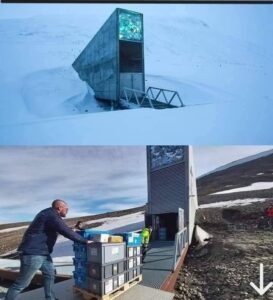Svalbard Seed Vault: Humanity’s Frozen Insurance Against Disaster

Hidden within the icy mountains of the Arctic, far from bustling cities and fragile political landscapes, lies one of humanity’s most extraordinary safeguards—the Svalbard Global Seed Vault. Often nicknamed “the doomsday vault,” this underground fortress quietly protects the building blocks of global agriculture, ensuring that food can be regrown even if catastrophe strikes.
Where Is the Vault?
The facility rests on Spitsbergen, a rugged island in Norway’s Svalbard archipelago, sitting about 1,300 kilometers from the North Pole. The choice of location was no accident. The region is geologically stable, isolated from conflict, naturally cold, and governed by Norway—a country respected for its neutrality and commitment to environmental protection. This makes it an ideal refuge for the world’s most precious biological resource: seeds.
Why Was It Created?
Opened in 2008, the vault was designed as a backup for global food security. Wars, climate change, disease outbreaks, and natural disasters put local seed banks at constant risk. If one of those vital collections were destroyed, the vault provides a lifeline. It functions as a global insurance policy—not something for daily use, but a last-resort safeguard when humanity’s food supply is threatened.
How Does It Work?
Carved deep into a mountain, the vault relies on Arctic permafrost to help keep its chambers cold. Even if mechanical refrigeration fails, the mountain itself acts as a natural freezer. Inside, shelves can store up to 4.5 million seed varieties—from staple crops like wheat, rice, and corn to rare plants that sustain regional diets and strengthen biodiversity.
Nations and organizations send their seeds sealed in packages, which remain their property. The vault merely keeps them safe—like a bank holding deposit boxes that only the original owners can access.
Has It Been Used Yet?
Although intended for emergencies, the vault has already fulfilled its purpose. During the Syrian civil war, the conflict destroyed critical seed banks in Aleppo. Scientists retrieved duplicate samples from Svalbard to rebuild collections in Lebanon and Morocco, proving the vault’s real-world importance.
An International Effort
More than one million seed samples have been placed in Svalbard by over 70 countries and institutions. The project is overseen by Norway’s government, NordGen (the Nordic Genetic Resource Center), and the Crop Trust—an international organization dedicated to preserving crop diversity. Together, they ensure that the vault remains a secure, long-term resource for the entire planet.
A Beacon of Resilience
The Svalbard Global Seed Vault rarely makes headlines, but its mission is profound. In a world where crises can feel overwhelming, it stands as a symbol of foresight and cooperation—a silent ark frozen in the Arctic, holding the possibility of renewal for future generations.
It reminds us that the future of food depends not only on science and technology but on the preservation of diversity. And that even at the edge of the world, hope for tomorrow is being carefully stored—one seed at a time.